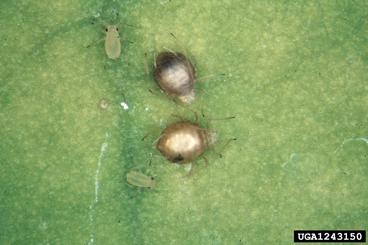R. L. Hines and W. D. Hutchison
Department of Entomology, University of Minnesota
Introduction
The cabbage aphid, Brevicoryne brassicae (L.), and the green peach aphid, Myzus persicae (Sulzer), are found on cole crops worldwide. The cabbage aphid feeds only on plants in the Cruciferae family (cole crops, mustard, etc.), with serious outbreaks occurring only sporadically. The green peach aphid feeds on over 300 species of plants and does not cause serious damage on cole crops.


Biology & Life Cycle
Cabbage aphids (CA) are grayish-green with a waxy covering that gives them a grayish-white appearance. CA have short cornicles (tube-like structures at the tip of the abdomen) and feed on the underside of leaves in large clusters, in the center of cabbage heads, or on the youngest leaves. Adults are present in both wingless and winged form. However, wingless females producing live young (nymphs), are the most common. Because of their rapid development time (8-12 days from first-instar nymph to adult), asexual reproduction (males not needed), and extended reproductive life-span (30+ days at 5-6 nymphs/day). Cabbage aphids complete up to 15 generations (often overlapping) during the growing season. Cabbage aphid overwinters as black eggs in host plant debris near the soil surface.
Green peach aphids (GPA) are yellowish-green, without a waxy coating, and have long cornicles. GPA can also be a serious winter greenhouse pest. GPA overwinters as an egg on peach or stone fruits; however, the degree to which GPA can consistently overwinter in the Midwest is unknown.
Damage
Aphid outbreaks and damaging populations of both aphid species will usually occur only under dry hot weather in the Midwest. Under cool or humid conditions, their populations are usually kept in check by beneficial insects (predators and parasites), or fungal pathogens, respectively.
Feeding damage from large numbers of aphids can kill seedlings and young transplants. On larger plants, feeding damage results in curling and yellowing leaves, stunting plant growth, and deforming developing heads.
Contamination by dead aphids in the head or wrapper leaves can also be a problem. Dead aphids do not wash off easily and will cause a head to be unsuitable for fresh market sales.
Management Options
Biological Control

Diaeretiella rapae (McIntosh), (Hymenoptera: Aphidiidae), is the most common parasite of CA. The female is dark brown and 3 mm (1/8 inch) in length. Eggs are deposited into half-grown nymphs, preferring 2nd-4th instars over 1st instar nymphs or adults. Wasp larvae develop inside the aphid and emerge from the aphid mummy (light brown harden shell of the host aphid) by cutting an exit hole in the mummy. The wasp overwinters as a fully grown larva in the mummy.
Although, D. rapae is a very common parasite, it is not always effective in controlling aphid populations. When wasp populations are large enough to be effective, the aphid population has usually exceeded damage thresholds. Also, D. rapae itself may often be killed by hyperparasites.
Small colonies of aphids can be effectively controlled by predators such as ladybird beetles, syrphid fly larvae, and lacewing larvae. Also, in wet/or humid weather, fungal epidemics can help control aphid populations.
Other Control Methods
Since the CA overwinters as a black egg in host plant debris, the destruction of these remains at the end of the season will help in killing overwintering aphids. Aphids may also be controlled with insecticidal (fatty-acid) soaps used at the recommended rates (e.g., Safer Soap ); however we have very little data on the effectiveness of these products.
For the most effective control, time applications of insecticides early in infestation so as not to kill beneficials. Also, time the application of insecticidal soaps when the maximum number of wasps are still in the aphid mummies. This will help to prevent the resurgence of aphid infestations.
Action Thresholds
Although we do not have action thresholds for aphids on cole crops, insecticide applications specifically for aphids are usually only needed when high populations (e.g., >50/plant) are present on very young seedlings/transplants, up to about 7 leaf stage, or near harvest-as a contaminant/marketability concern. Early to mid-season treatment decision for aphids should clearly be dependent upon the abundance of beneficial insects, plant growth stage and weather conditions. Conventional insecticides applied for the Lepidopteran pest complex will also usually suppress aphid populations. However, excessive use of multiple pyrethroid or carbamate (e.g., Sevin) treatments will often lead to aphid outbreaks. To ensure proper use of insecticides, refer to the most recent edition of the Midwest Vegetable Production Guide.
References
- Growing Broccoli and Cauliflower in Minnesota (FO-1862)
- Cornell University. 2003. Vegetable Disease ID and Management http://vegetablemdonline.ppath.cornell.edu/
- Diseases of Cole Crops (MN) (FS-1169)
- Midwest Vegetable Production Guide
- Alternatives in Insect Management (IL) (BU 5854)
- Biological Control of Insect Pests of Cabbage and Other Cruicifers (WI) (BU-6198)
- Biological Control of Insects and Mites (BU-6428)
- Ch.8 of "Vegetable Insect Management with Emphasis on the Midwest" Meister Publishing Co. Willoughby, Ohio.